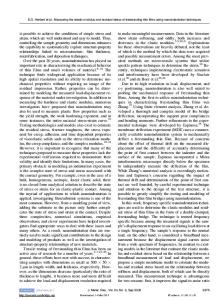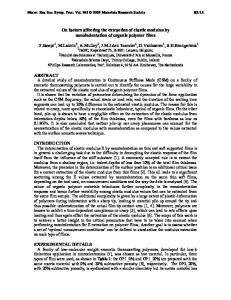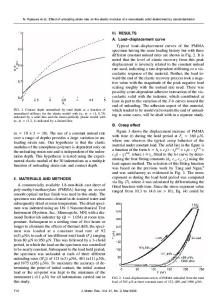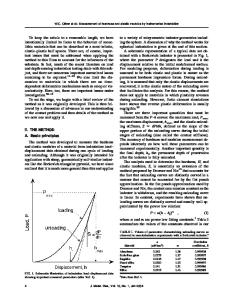Influence ofresidual stress on elastic modulus and hardness of soda-lime glass measured by nanoindentation
- PDF / 1,022,306 Bytes
- 11 Pages / 612 x 792 pts (letter) Page_size
- 68 Downloads / 429 Views
The influence of stress on the elastic modulus E and hardness H in soda-lime glass was studied in the Vickers residual stress field by nanoindentation. The Oliver–Pharr method of analysis first gave higher values of E and H, but after correcting for the pileup contact areas around the nanoindents, results consistent with literature values were obtained at regions in the stress field where the stresses were either low or close to zero. Determination of the pileup contact areas was made possible by the use of the atomic force microscope, which has facility for generating cross-section images of the indents. The elastic modulus was found to decrease with stress, which is explained with reference to the influence of applied stresses on the Si–O–Si bond angle. The hardness on the other hand did not depend on the stresses except in the region very close to the edge of the Vickers indent where the stresses are high.
I. INTRODUCTION A. Background
The Oliver–Pharr analysis is perhaps the most widely used method1 for determining the elastic modulus E and the hardness H from nanoindentation data. Tsui, Oliver, and Pharr2 investigated the influence of applied bending stress on the hardness H and elastic modulus E of an aluminium alloy when measured in nanoindentation using the Oliver–Pharr method. Initially, they found an apparent dependence of H and E on stress, but upon a critical examination of the parameters used to define these mechanical properties in nanoindentation analyses, no such dependence was found. The results of that study have inspired the present work, although two main differences may be mentioned between the two studies: (i) glass, an amorphous material was studied in this work instead of aluminium, which is crystalline, and (ii) the atomic force microscope (AFM) with facility for imaging and profiling an indent, was used in this work instead of the scanned optical photographs used in the previous work. The choice of glass was intended to afford the opportunity to study a material that has been reported to exhibit nonlinear elastic behavior under certain loading conditions3,4 while use of the AFM was intended to enhance characterization of the geometry of the residual
indent in trying to experimentally determine the projected contact area A of the indentation. The need to practically determine the projected contact area A stems from the fact that the Oliver–Pharr5 analysis alone has been found to underestimate A in certain materials and under certain loading conditions,2,6,7 leading thereby to overestimations in the measured values of the hardness and elastic modulus. The contact area is defined for a perfect Berkovich indenter as A = 24.56hc2
where hc is the contact depth, and is obtained from the load (Pmax) at the maximum depth of penetration hmax and the contact stiffness S as hc = hmax − ⑀
J. Mater. Res., Vol. 19, No. 10, Oct 2004
http://journals.cambridge.org
Downloaded: 13 Mar 2015
Pmax . S
(2)
For a Berkovich indenter, the indenter geometry constant ⑀, has the typical value of 0.75,1 althou
Data Loading...










